MAZDA MX-5 1997 Factory Manual PDF
Manufacturer: MAZDA, Model Year: 1997, Model line: MX-5, Model: MAZDA MX-5 1997Pages: 514, PDF Size: 17.89 MB
Page 61 of 514
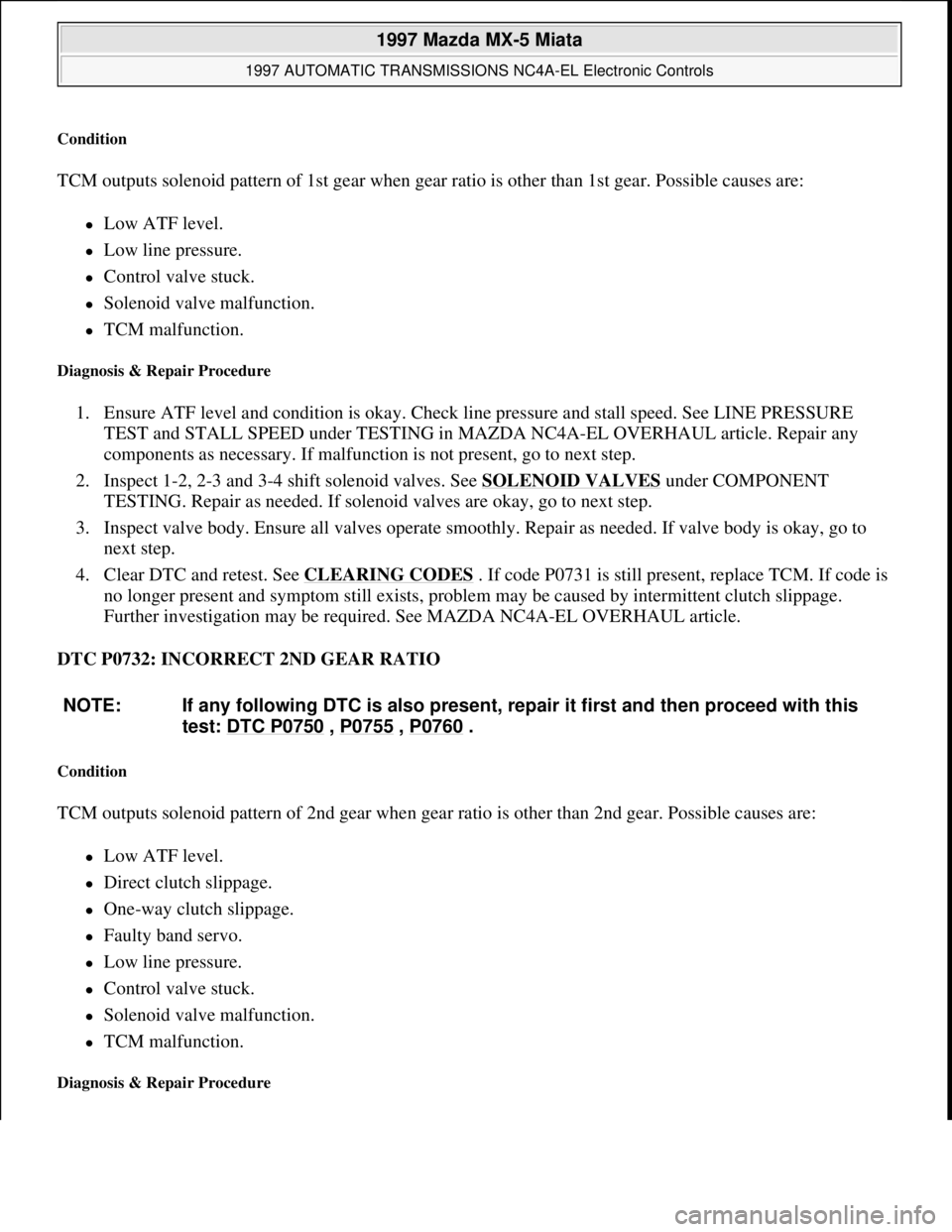
Condition
TCM outputs solenoid pattern of 1st gear when gear ratio is other than 1st gear. Possible causes are:
ïŽLow ATF level.
ïŽLow line pressure.
ïŽControl valve stuck.
ïŽSolenoid valve malfunction.
ïŽTCM malfunction.
Diagnosis & Repair Procedure
1. Ensure ATF level and condition is okay. Check line pressure and stall speed. See LINE PRESSURE
TEST and STALL SPEED under TESTING in MAZDA NC4A-EL OVERHAUL article. Repair any
components as necessary. If malfunction is not present, go to next step.
2. Inspect 1-2, 2-3 and 3-4 shift solenoid valves. See SOLENOID VALVES
under COMPONENT
TESTING. Repair as needed. If solenoid valves are okay, go to next step.
3. Inspect valve body. Ensure all valves operate smoothly. Repair as needed. If valve body is okay, go to
next step.
4. Clear DTC and retest. See CLEARING CODES
. If code P0731 is still present, replace TCM. If code is
no longer present and symptom still exists, problem may be caused by intermittent clutch slippage.
Further investigation may be required. See MAZDA NC4A-EL OVERHAUL article.
DTC P0732: INCORRECT 2ND GEAR RATIO
Condition
TCM outputs solenoid pattern of 2nd gear when gear ratio is other than 2nd gear. Possible causes are:
ïŽLow ATF level.
ïŽDirect clutch slippage.
ïŽOne-way clutch slippage.
ïŽFaulty band servo.
ïŽLow line pressure.
ïŽControl valve stuck.
ïŽSolenoid valve malfunction.
ïŽTCM malfunction.
Diagnosis & Repair Procedure
NOTE: If any following DTC is also present, repair it first and then proceed with this
test: DTC P0750
, P0755 , P0760 .
1997 Mazda MX-5 Miata
1997 AUTOMATIC TRANSMISSIONS NC4A-EL Electronic Controls
Microsoft
Sunday, July 05, 2009 1:35:04 PMPage 13 ÂĐ 2005 Mitchell Repair Information Company, LLC.
Page 62 of 514
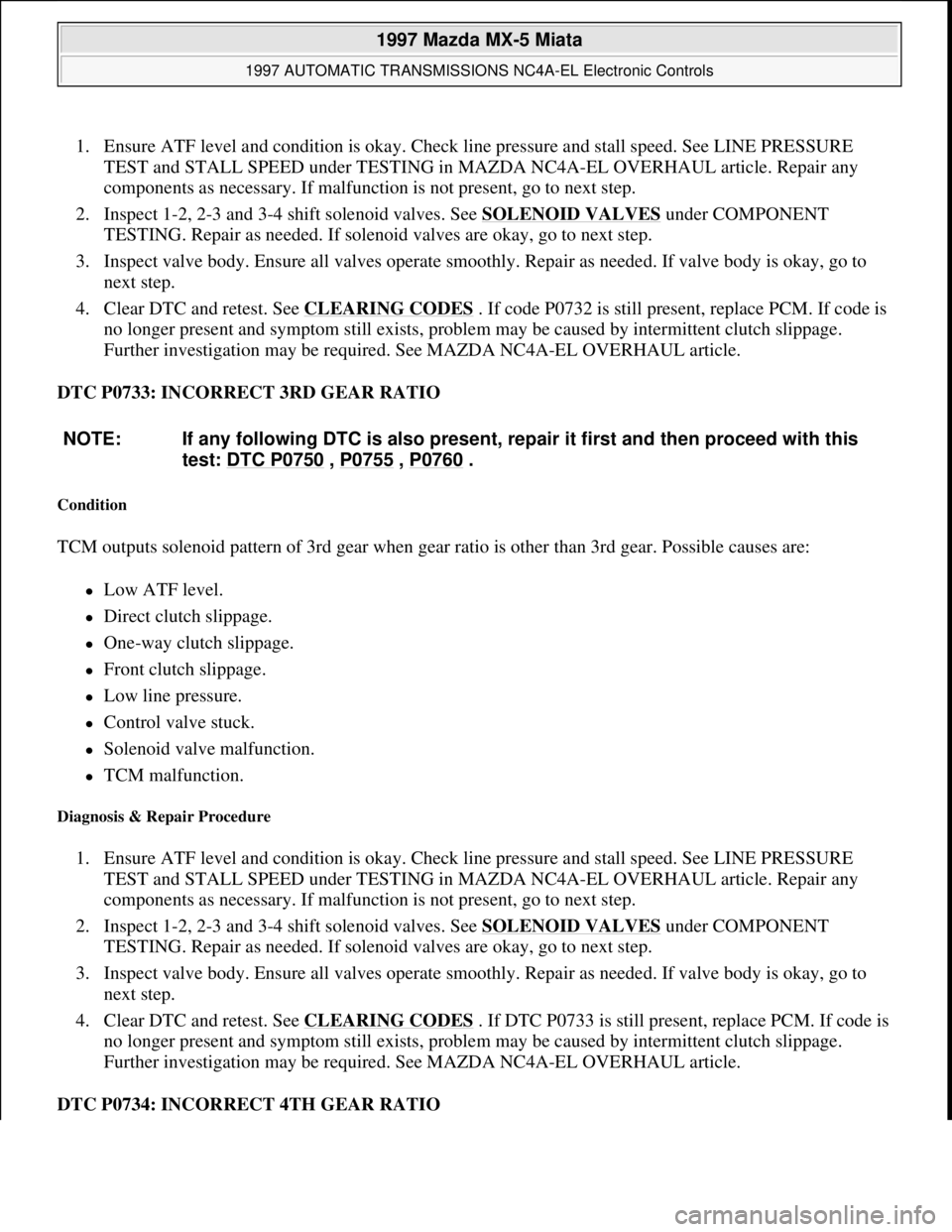
1. Ensure ATF level and condition is okay. Check line pressure and stall speed. See LINE PRESSURE
TEST and STALL SPEED under TESTING in MAZDA NC4A-EL OVERHAUL article. Repair any
components as necessary. If malfunction is not present, go to next step.
2. Inspect 1-2, 2-3 and 3-4 shift solenoid valves. See SOLENOID VALVES
under COMPONENT
TESTING. Repair as needed. If solenoid valves are okay, go to next step.
3. Inspect valve body. Ensure all valves operate smoothly. Repair as needed. If valve body is okay, go to
next step.
4. Clear DTC and retest. See CLEARING CODES
. If code P0732 is still present, replace PCM. If code is
no longer present and symptom still exists, problem may be caused by intermittent clutch slippage.
Further investigation may be required. See MAZDA NC4A-EL OVERHAUL article.
DTC P0733: INCORRECT 3RD GEAR RATIO
Condition
TCM outputs solenoid pattern of 3rd gear when gear ratio is other than 3rd gear. Possible causes are:
ïŽLow ATF level.
ïŽDirect clutch slippage.
ïŽOne-way clutch slippage.
ïŽFront clutch slippage.
ïŽLow line pressure.
ïŽControl valve stuck.
ïŽSolenoid valve malfunction.
ïŽTCM malfunction.
Diagnosis & Repair Procedure
1. Ensure ATF level and condition is okay. Check line pressure and stall speed. See LINE PRESSURE
TEST and STALL SPEED under TESTING in MAZDA NC4A-EL OVERHAUL article. Repair any
components as necessary. If malfunction is not present, go to next step.
2. Inspect 1-2, 2-3 and 3-4 shift solenoid valves. See SOLENOID VALVES
under COMPONENT
TESTING. Repair as needed. If solenoid valves are okay, go to next step.
3. Inspect valve body. Ensure all valves operate smoothly. Repair as needed. If valve body is okay, go to
next step.
4. Clear DTC and retest. See CLEARING CODES
. If DTC P0733 is still present, replace PCM. If code is
no longer present and symptom still exists, problem may be caused by intermittent clutch slippage.
Further investigation may be required. See MAZDA NC4A-EL OVERHAUL article.
DTC P0734: INCORRECT 4TH GEAR RATIO NOTE: If any following DTC is also present, repair it first and then proceed with this
test: DTC P0750
, P0755 , P0760 .
1997 Mazda MX-5 Miata
1997 AUTOMATIC TRANSMISSIONS NC4A-EL Electronic Controls
Microsoft
Sunday, July 05, 2009 1:35:04 PMPage 14 ÂĐ 2005 Mitchell Repair Information Company, LLC.
Page 63 of 514
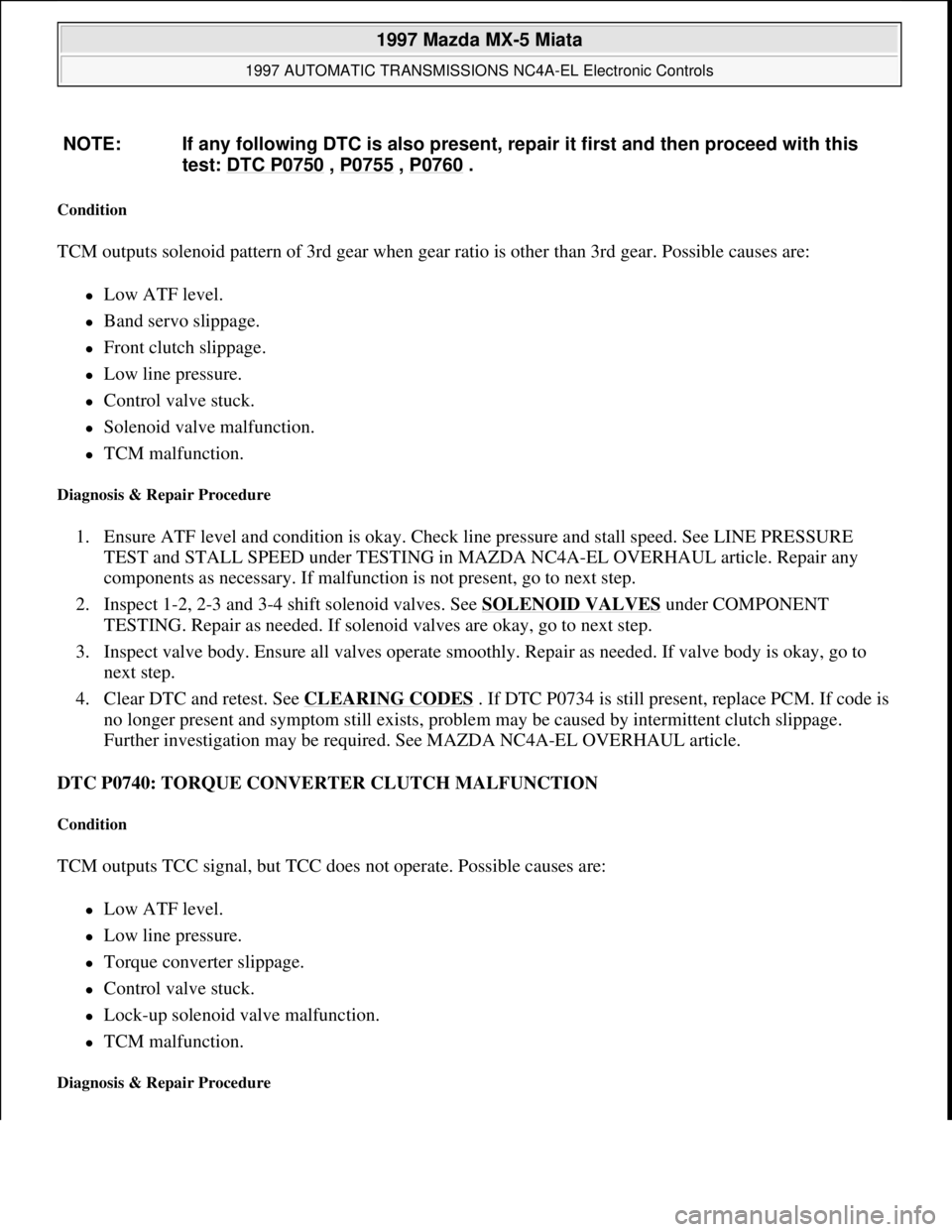
Condition
TCM outputs solenoid pattern of 3rd gear when gear ratio is other than 3rd gear. Possible causes are:
ïŽLow ATF level.
ïŽBand servo slippage.
ïŽFront clutch slippage.
ïŽLow line pressure.
ïŽControl valve stuck.
ïŽSolenoid valve malfunction.
ïŽTCM malfunction.
Diagnosis & Repair Procedure
1. Ensure ATF level and condition is okay. Check line pressure and stall speed. See LINE PRESSURE
TEST and STALL SPEED under TESTING in MAZDA NC4A-EL OVERHAUL article. Repair any
components as necessary. If malfunction is not present, go to next step.
2. Inspect 1-2, 2-3 and 3-4 shift solenoid valves. See SOLENOID VALVES
under COMPONENT
TESTING. Repair as needed. If solenoid valves are okay, go to next step.
3. Inspect valve body. Ensure all valves operate smoothly. Repair as needed. If valve body is okay, go to
next step.
4. Clear DTC and retest. See CLEARING CODES
. If DTC P0734 is still present, replace PCM. If code is
no longer present and symptom still exists, problem may be caused by intermittent clutch slippage.
Further investigation may be required. See MAZDA NC4A-EL OVERHAUL article.
DTC P0740: TORQUE CONVERTER CLUTCH MALFUNCTION
Condition
TCM outputs TCC signal, but TCC does not operate. Possible causes are:
ïŽLow ATF level.
ïŽLow line pressure.
ïŽTorque converter slippage.
ïŽControl valve stuck.
ïŽLock-up solenoid valve malfunction.
ïŽTCM malfunction.
Diagnosis & Repair Procedure
NOTE: If any following DTC is also present, repair it first and then proceed with this
test: DTC P0750
, P0755 , P0760 .
1997 Mazda MX-5 Miata
1997 AUTOMATIC TRANSMISSIONS NC4A-EL Electronic Controls
Microsoft
Sunday, July 05, 2009 1:35:04 PMPage 15 ÂĐ 2005 Mitchell Repair Information Company, LLC.
Page 64 of 514
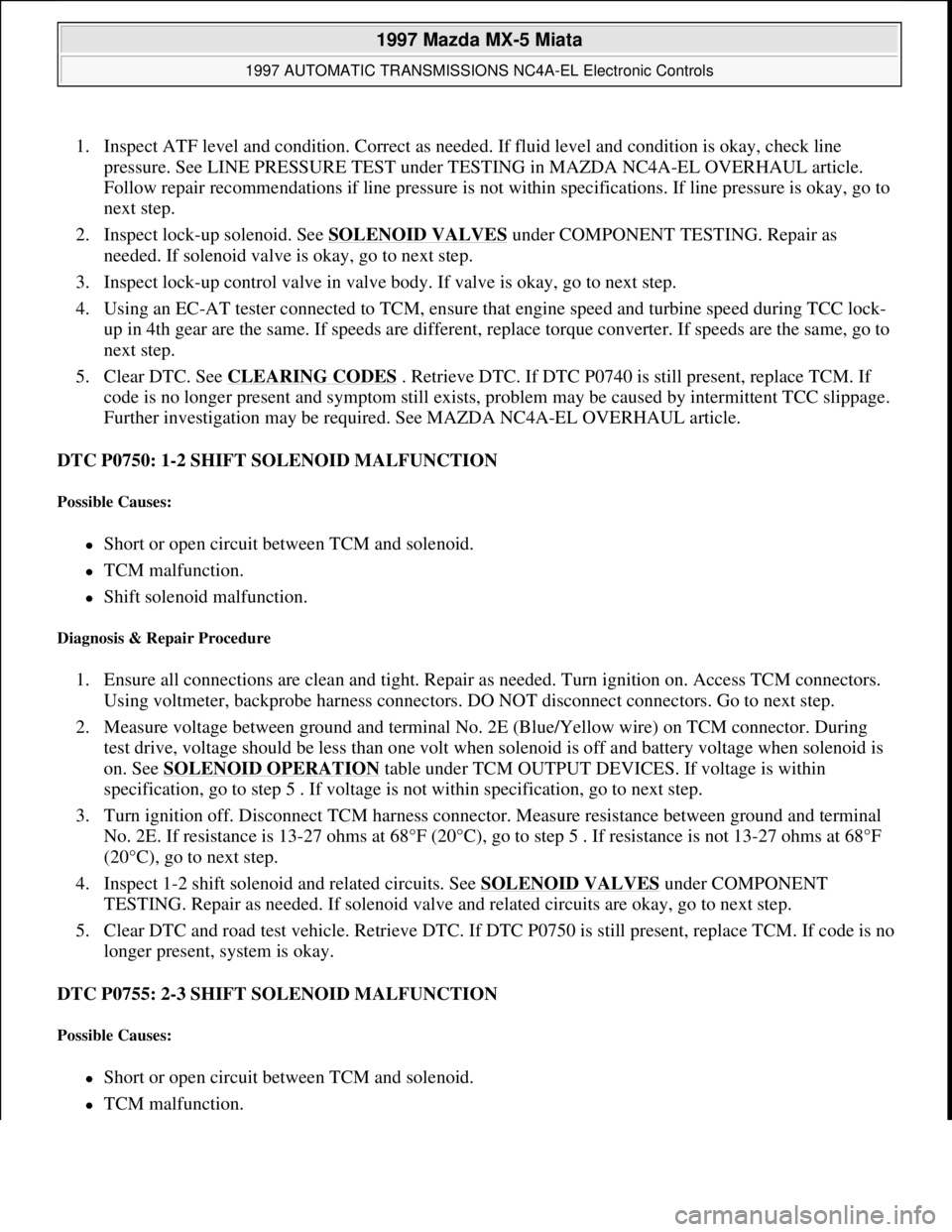
1. Inspect ATF level and condition. Correct as needed. If fluid level and condition is okay, check line
pressure. See LINE PRESSURE TEST under TESTING in MAZDA NC4A-EL OVERHAUL article.
Follow repair recommendations if line pressure is not within specifications. If line pressure is okay, go to
next step.
2. Inspect lock-up solenoid. See SOLENOID VALVES
under COMPONENT TESTING. Repair as
needed. If solenoid valve is okay, go to next step.
3. Inspect lock-up control valve in valve body. If valve is okay, go to next step.
4. Using an EC-AT tester connected to TCM, ensure that engine speed and turbine speed during TCC lock-
up in 4th gear are the same. If speeds are different, replace torque converter. If speeds are the same, go to
next step.
5. Clear DTC. See CLEARING CODES
. Retrieve DTC. If DTC P0740 is still present, replace TCM. If
code is no longer present and symptom still exists, problem may be caused by intermittent TCC slippage.
Further investigation may be required. See MAZDA NC4A-EL OVERHAUL article.
DTC P0750: 1-2 SHIFT SOLENOID MALFUNCTION
Possible Causes:
ïŽShort or open circuit between TCM and solenoid.
ïŽTCM malfunction.
ïŽShift solenoid malfunction.
Diagnosis & Repair Procedure
1. Ensure all connections are clean and tight. Repair as needed. Turn ignition on. Access TCM connectors.
Using voltmeter, backprobe harness connectors. DO NOT disconnect connectors. Go to next step.
2. Measure voltage between ground and terminal No. 2E (Blue/Yellow wire) on TCM connector. During
test drive, voltage should be less than one volt when solenoid is off and battery voltage when solenoid is
on. See SOLENOID OPERATION
table under TCM OUTPUT DEVICES. If voltage is within
specification, go to step 5 . If voltage is not within specification, go to next step.
3. Turn ignition off. Disconnect TCM harness connector. Measure resistance between ground and terminal
No. 2E. If resistance is 13-27 ohms at 68°F (20°C), go to step 5 . If resistance is not 13-27 ohms at 68°F
(20°C), go to next step.
4. Inspect 1-2 shift solenoid and related circuits. See SOLENOID VALVES
under COMPONENT
TESTING. Repair as needed. If solenoid valve and related circuits are okay, go to next step.
5. Clear DTC and road test vehicle. Retrieve DTC. If DTC P0750 is still present, replace TCM. If code is no
longer present, system is okay.
DTC P0755: 2-3 SHIFT SOLENOID MALFUNCTION
Possible Causes:
ïŽShort or open circuit between TCM and solenoid.
ïŽTCM malfunction.
1997 Mazda MX-5 Miata
1997 AUTOMATIC TRANSMISSIONS NC4A-EL Electronic Controls
Microsoft
Sunday, July 05, 2009 1:35:04 PMPage 16 ÂĐ 2005 Mitchell Repair Information Company, LLC.
Page 65 of 514
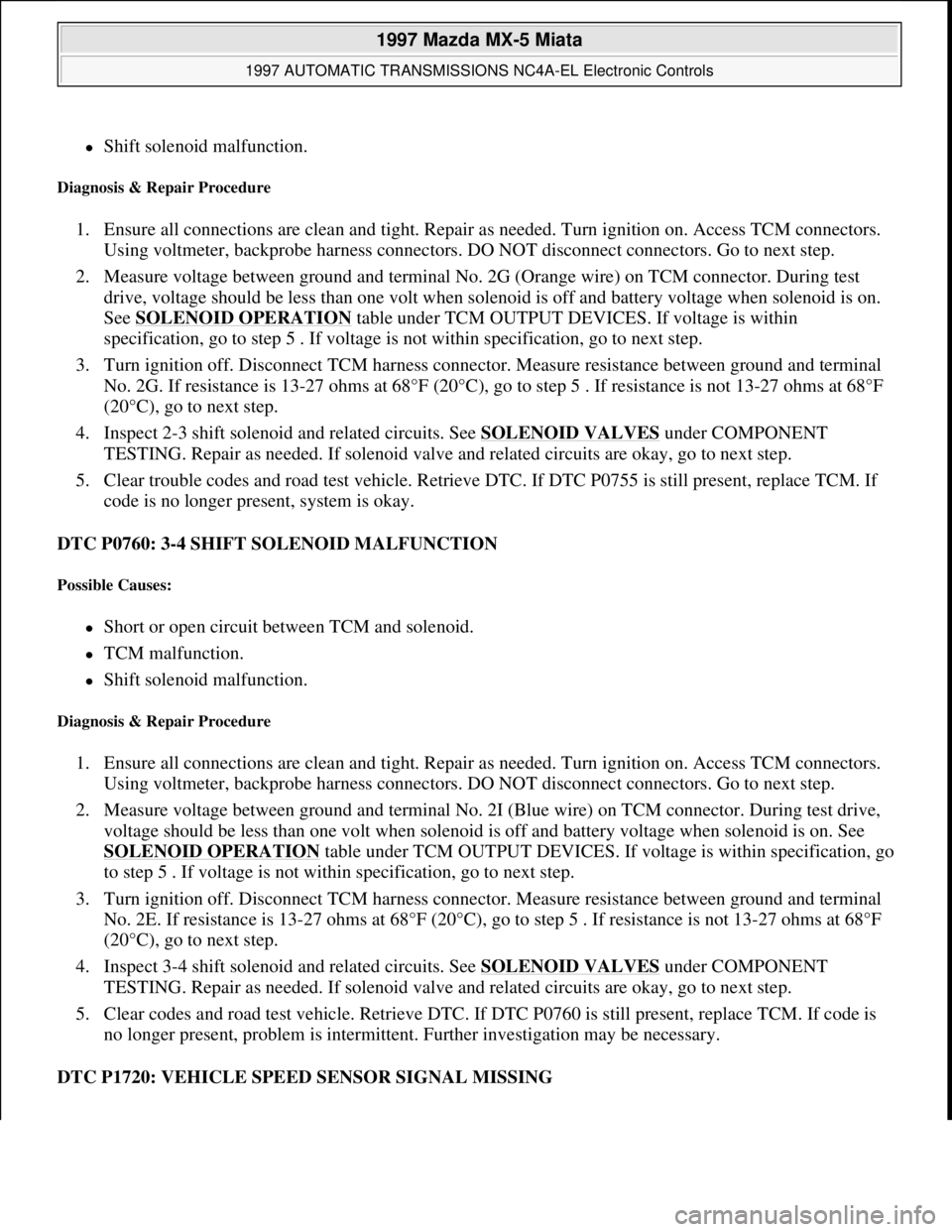
ïŽShift solenoid malfunction.
Diagnosis & Repair Procedure
1. Ensure all connections are clean and tight. Repair as needed. Turn ignition on. Access TCM connectors.
Using voltmeter, backprobe harness connectors. DO NOT disconnect connectors. Go to next step.
2. Measure voltage between ground and terminal No. 2G (Orange wire) on TCM connector. During test
drive, voltage should be less than one volt when solenoid is off and battery voltage when solenoid is on.
See SOLENOID OPERATION
table under TCM OUTPUT DEVICES. If voltage is within
specification, go to step 5 . If voltage is not within specification, go to next step.
3. Turn ignition off. Disconnect TCM harness connector. Measure resistance between ground and terminal
No. 2G. If resistance is 13-27 ohms at 68°F (20°C), go to step 5 . If resistance is not 13-27 ohms at 68°F
(20°C), go to next step.
4. Inspect 2-3 shift solenoid and related circuits. See SOLENOID VALVES
under COMPONENT
TESTING. Repair as needed. If solenoid valve and related circuits are okay, go to next step.
5. Clear trouble codes and road test vehicle. Retrieve DTC. If DTC P0755 is still present, replace TCM. If
code is no longer present, system is okay.
DTC P0760: 3-4 SHIFT SOLENOID MALFUNCTION
Possible Causes:
ïŽShort or open circuit between TCM and solenoid.
ïŽTCM malfunction.
ïŽShift solenoid malfunction.
Diagnosis & Repair Procedure
1. Ensure all connections are clean and tight. Repair as needed. Turn ignition on. Access TCM connectors.
Using voltmeter, backprobe harness connectors. DO NOT disconnect connectors. Go to next step.
2. Measure voltage between ground and terminal No. 2I (Blue wire) on TCM connector. During test drive,
voltage should be less than one volt when solenoid is off and battery voltage when solenoid is on. See
SOLENOID OPERATION
table under TCM OUTPUT DEVICES. If voltage is within specification, go
to step 5 . If voltage is not within specification, go to next step.
3. Turn ignition off. Disconnect TCM harness connector. Measure resistance between ground and terminal
No. 2E. If resistance is 13-27 ohms at 68°F (20°C), go to step 5 . If resistance is not 13-27 ohms at 68°F
(20°C), go to next step.
4. Inspect 3-4 shift solenoid and related circuits. See SOLENOID VALVES
under COMPONENT
TESTING. Repair as needed. If solenoid valve and related circuits are okay, go to next step.
5. Clear codes and road test vehicle. Retrieve DTC. If DTC P0760 is still present, replace TCM. If code is
no longer present, problem is intermittent. Further investigation may be necessary.
DTC P1720: VEHICLE SPEED SENSOR SIGNAL MISSING
1997 Mazda MX-5 Miata
1997 AUTOMATIC TRANSMISSIONS NC4A-EL Electronic Controls
Microsoft
Sunday, July 05, 2009 1:35:04 PMPage 17 ÂĐ 2005 Mitchell Repair Information Company, LLC.
Page 66 of 514
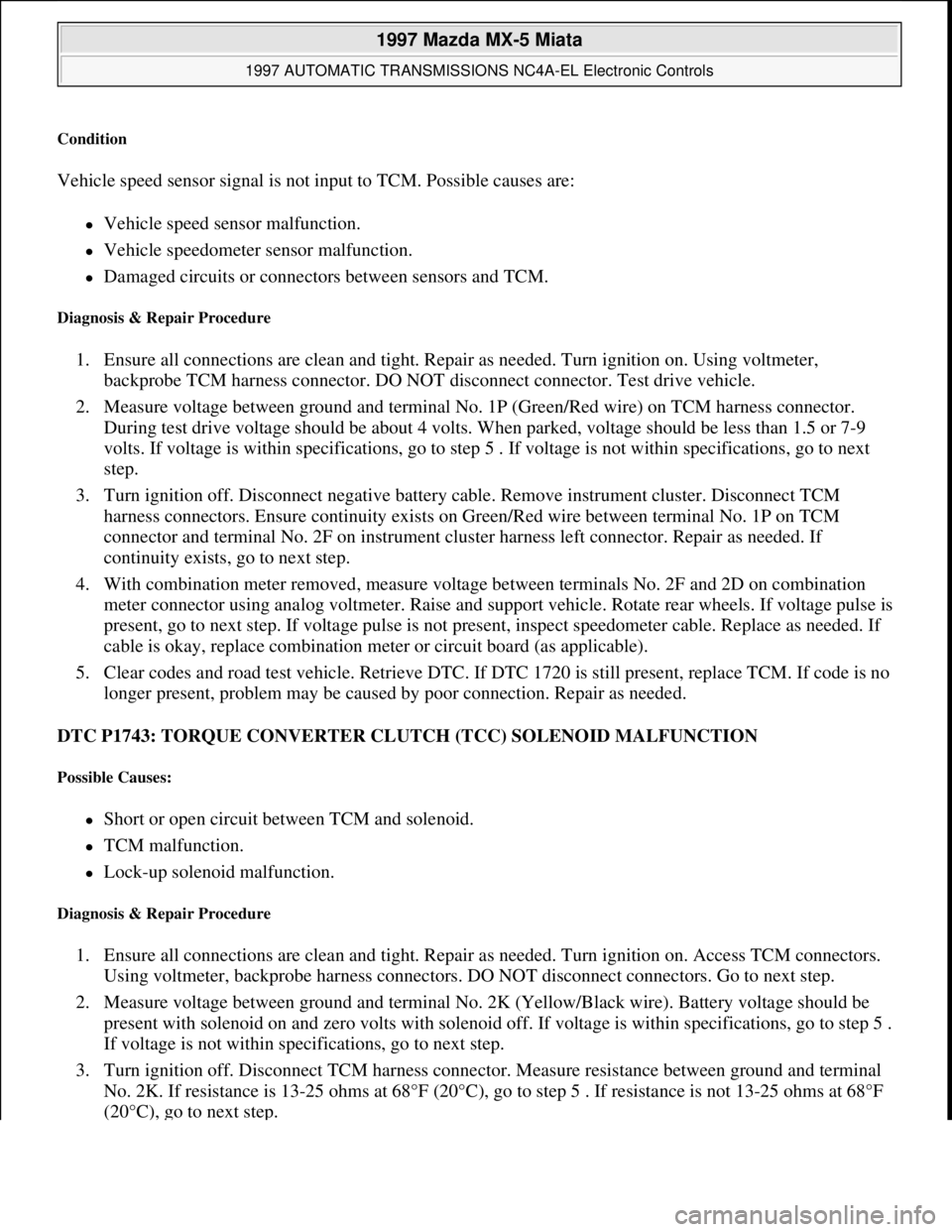
Condition
Vehicle speed sensor signal is not input to TCM. Possible causes are:
ïŽVehicle speed sensor malfunction.
ïŽVehicle speedometer sensor malfunction.
ïŽDamaged circuits or connectors between sensors and TCM.
Diagnosis & Repair Procedure
1. Ensure all connections are clean and tight. Repair as needed. Turn ignition on. Using voltmeter,
backprobe TCM harness connector. DO NOT disconnect connector. Test drive vehicle.
2. Measure voltage between ground and terminal No. 1P (Green/Red wire) on TCM harness connector.
During test drive voltage should be about 4 volts. When parked, voltage should be less than 1.5 or 7-9
volts. If voltage is within specifications, go to step 5 . If voltage is not within specifications, go to next
step.
3. Turn ignition off. Disconnect negative battery cable. Remove instrument cluster. Disconnect TCM
harness connectors. Ensure continuity exists on Green/Red wire between terminal No. 1P on TCM
connector and terminal No. 2F on instrument cluster harness left connector. Repair as needed. If
continuity exists, go to next step.
4. With combination meter removed, measure voltage between terminals No. 2F and 2D on combination
meter connector using analog voltmeter. Raise and support vehicle. Rotate rear wheels. If voltage pulse is
present, go to next step. If voltage pulse is not present, inspect speedometer cable. Replace as needed. If
cable is okay, replace combination meter or circuit board (as applicable).
5. Clear codes and road test vehicle. Retrieve DTC. If DTC 1720 is still present, replace TCM. If code is no
longer present, problem may be caused by poor connection. Repair as needed.
DTC P1743: TORQUE CONVERTER CLUTCH (TCC) SOLENOID MALFUNCTION
Possible Causes:
ïŽShort or open circuit between TCM and solenoid.
ïŽTCM malfunction.
ïŽLock-up solenoid malfunction.
Diagnosis & Repair Procedure
1. Ensure all connections are clean and tight. Repair as needed. Turn ignition on. Access TCM connectors.
Using voltmeter, backprobe harness connectors. DO NOT disconnect connectors. Go to next step.
2. Measure voltage between ground and terminal No. 2K (Yellow/Black wire). Battery voltage should be
present with solenoid on and zero volts with solenoid off. If voltage is within specifications, go to step 5 .
If voltage is not within specifications, go to next step.
3. Turn ignition off. Disconnect TCM harness connector. Measure resistance between ground and terminal
No. 2K. If resistance is 13-25 ohms at 68°F (20°C), go to step 5 . If resistance is not 13-25 ohms at 68°F
(20°C),
go to next step.
1997 Mazda MX-5 Miata
1997 AUTOMATIC TRANSMISSIONS NC4A-EL Electronic Controls
Microsoft
Sunday, July 05, 2009 1:35:04 PMPage 18 ÂĐ 2005 Mitchell Repair Information Company, LLC.
Page 67 of 514
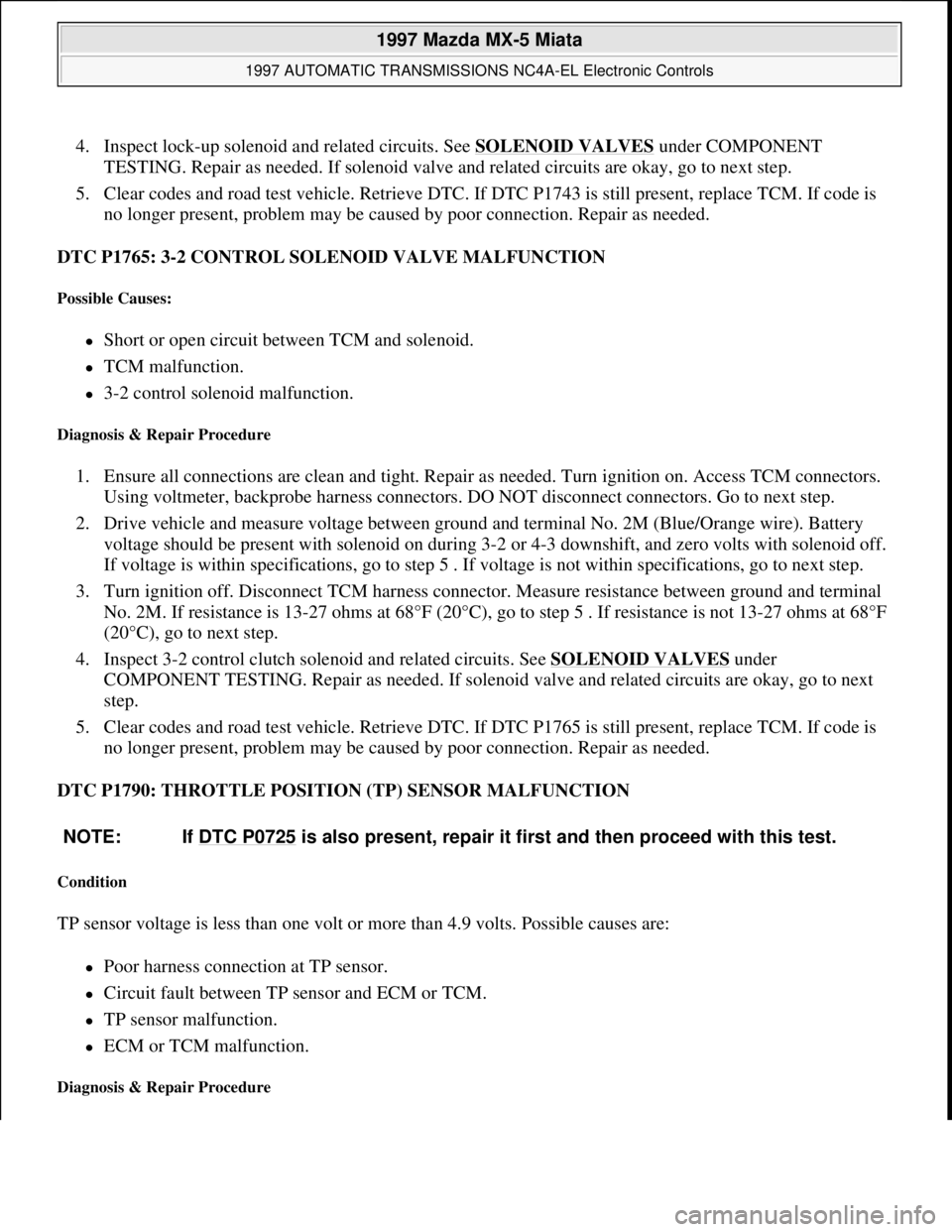
4. Inspect lock-up solenoid and related circuits. See SOLENOID VALVES under COMPONENT
TESTING. Repair as needed. If solenoid valve and related circuits are okay, go to next step.
5. Clear codes and road test vehicle. Retrieve DTC. If DTC P1743 is still present, replace TCM. If code is
no longer present, problem may be caused by poor connection. Repair as needed.
DTC P1765: 3-2 CONTROL SOLENOID VALVE MALFUNCTION
Possible Causes:
ïŽShort or open circuit between TCM and solenoid.
ïŽTCM malfunction.
ïŽ3-2 control solenoid malfunction.
Diagnosis & Repair Procedure
1. Ensure all connections are clean and tight. Repair as needed. Turn ignition on. Access TCM connectors.
Using voltmeter, backprobe harness connectors. DO NOT disconnect connectors. Go to next step.
2. Drive vehicle and measure voltage between ground and terminal No. 2M (Blue/Orange wire). Battery
voltage should be present with solenoid on during 3-2 or 4-3 downshift, and zero volts with solenoid off.
If voltage is within specifications, go to step 5 . If voltage is not within specifications, go to next step.
3. Turn ignition off. Disconnect TCM harness connector. Measure resistance between ground and terminal
No. 2M. If resistance is 13-27 ohms at 68°F (20°C), go to step 5 . If resistance is not 13-27 ohms at 68°F
(20°C), go to next step.
4. Inspect 3-2 control clutch solenoid and related circuits. See SOLENOID VALVES
under
COMPONENT TESTING. Repair as needed. If solenoid valve and related circuits are okay, go to next
step.
5. Clear codes and road test vehicle. Retrieve DTC. If DTC P1765 is still present, replace TCM. If code is
no longer present, problem may be caused by poor connection. Repair as needed.
DTC P1790: THROTTLE POSITION (TP) SENSOR MALFUNCTION
Condition
TP sensor voltage is less than one volt or more than 4.9 volts. Possible causes are:
ïŽPoor harness connection at TP sensor.
ïŽCircuit fault between TP sensor and ECM or TCM.
ïŽTP sensor malfunction.
ïŽECM or TCM malfunction.
Diagnosis & Repair Procedure
NOTE: If DTC P0725 is also present, repair it first and then proceed with this test.
1997 Mazda MX-5 Miata
1997 AUTOMATIC TRANSMISSIONS NC4A-EL Electronic Controls
Microsoft
Sunday, July 05, 2009 1:35:04 PMPage 19 ÂĐ 2005 Mitchell Repair Information Company, LLC.
Page 68 of 514
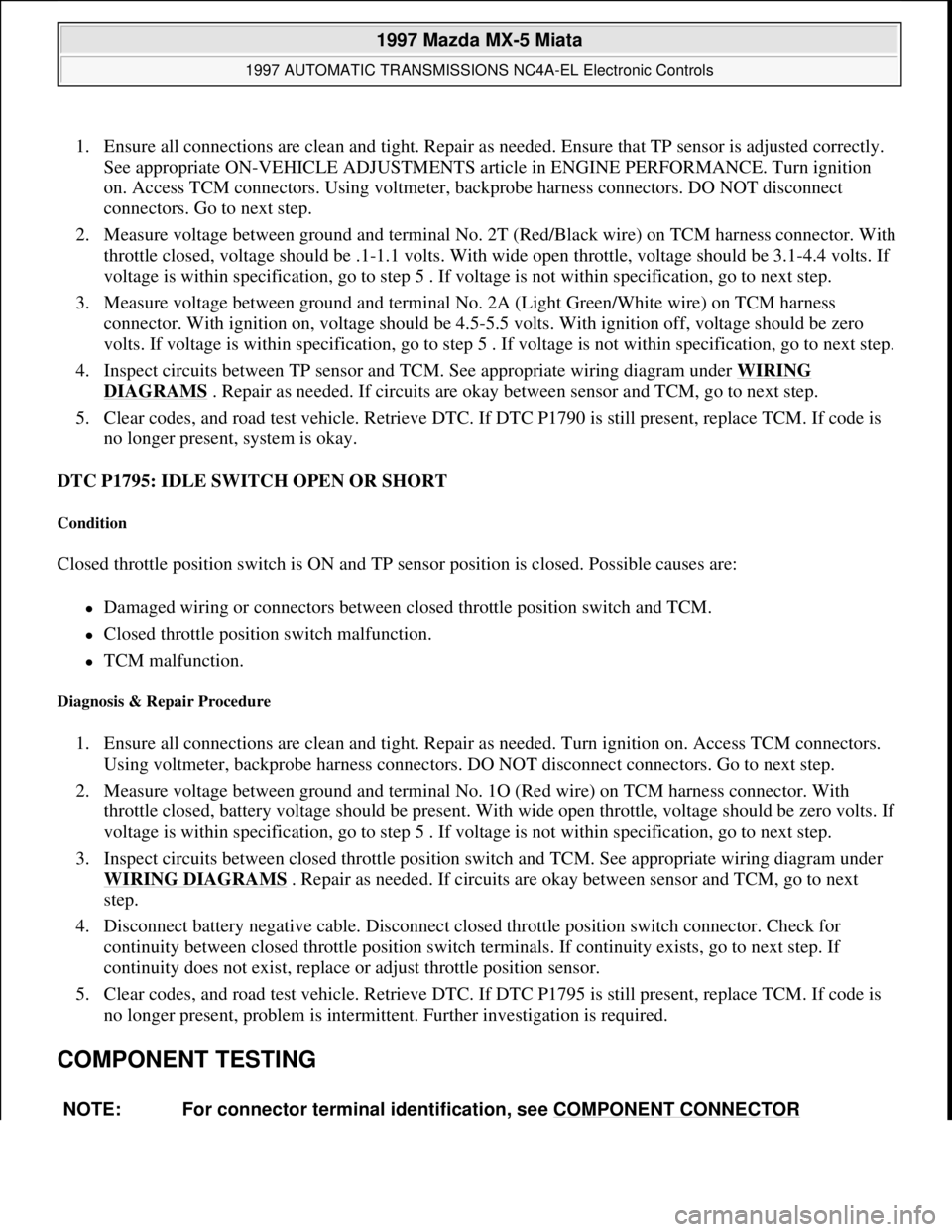
1. Ensure all connections are clean and tight. Repair as needed. Ensure that TP sensor is adjusted correctly.
See appropriate ON-VEHICLE ADJUSTMENTS article in ENGINE PERFORMANCE. Turn ignition
on. Access TCM connectors. Using voltmeter, backprobe harness connectors. DO NOT disconnect
connectors. Go to next step.
2. Measure voltage between ground and terminal No. 2T (Red/Black wire) on TCM harness connector. With
throttle closed, voltage should be .1-1.1 volts. With wide open throttle, voltage should be 3.1-4.4 volts. If
voltage is within specification, go to step 5 . If voltage is not within specification, go to next step.
3. Measure voltage between ground and terminal No. 2A (Light Green/White wire) on TCM harness
connector. With ignition on, voltage should be 4.5-5.5 volts. With ignition off, voltage should be zero
volts. If voltage is within specification, go to step 5 . If voltage is not within specification, go to next step.
4. Inspect circuits between TP sensor and TCM. See appropriate wiring diagram under WIRING
DIAGRAMS . Repair as needed. If circuits are okay between sensor and TCM, go to next step.
5. Clear codes, and road test vehicle. Retrieve DTC. If DTC P1790 is still present, replace TCM. If code is
no longer present, system is okay.
DTC P1795: IDLE SWITCH OPEN OR SHORT
Condition
Closed throttle position switch is ON and TP sensor position is closed. Possible causes are:
ïŽDamaged wiring or connectors between closed throttle position switch and TCM.
ïŽClosed throttle position switch malfunction.
ïŽTCM malfunction.
Diagnosis & Repair Procedure
1. Ensure all connections are clean and tight. Repair as needed. Turn ignition on. Access TCM connectors.
Using voltmeter, backprobe harness connectors. DO NOT disconnect connectors. Go to next step.
2. Measure voltage between ground and terminal No. 1O (Red wire) on TCM harness connector. With
throttle closed, battery voltage should be present. With wide open throttle, voltage should be zero volts. If
voltage is within specification, go to step 5 . If voltage is not within specification, go to next step.
3. Inspect circuits between closed throttle position switch and TCM. See appropriate wiring diagram under
WIRING DIAGRAMS
. Repair as needed. If circuits are okay between sensor and TCM, go to next
step.
4. Disconnect battery negative cable. Disconnect closed throttle position switch connector. Check for
continuity between closed throttle position switch terminals. If continuity exists, go to next step. If
continuity does not exist, replace or adjust throttle position sensor.
5. Clear codes, and road test vehicle. Retrieve DTC. If DTC P1795 is still present, replace TCM. If code is
no longer present, problem is intermittent. Further investigation is required.
COMPONENT TESTING
NOTE: For connector terminal identification, see COMPONENT CONNECTOR
1997 Mazda MX-5 Miata
1997 AUTOMATIC TRANSMISSIONS NC4A-EL Electronic Controls
Microsoft
Sunday, July 05, 2009 1:35:04 PMPage 20 ÂĐ 2005 Mitchell Repair Information Company, LLC.
Page 69 of 514
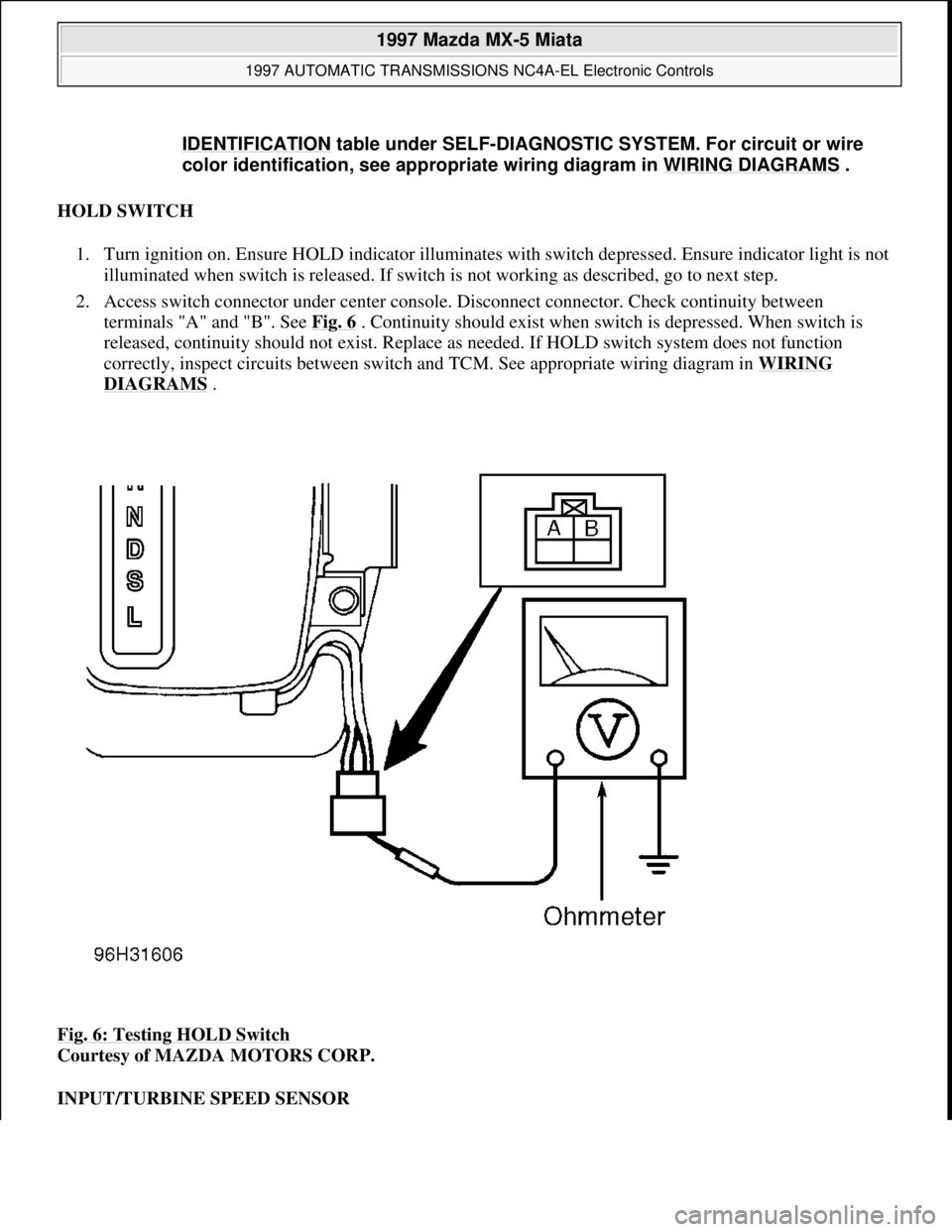
HOLD SWITCH
1. Turn ignition on. Ensure HOLD indicator illuminates with switch depressed. Ensure indicator light is not
illuminated when switch is released. If switch is not working as described, go to next step.
2. Access switch connector under center console. Disconnect connector. Check continuity between
terminals "A" and "B". See Fig. 6
. Continuity should exist when switch is depressed. When switch is
released, continuity should not exist. Replace as needed. If HOLD switch system does not function
correctly, inspect circuits between switch and TCM. See appropriate wiring diagram in WIRING
DIAGRAMS .
Fig. 6: Testing HOLD Switch
Courtesy of MAZDA MOTORS CORP.
INPUT/TURBINE SPEED SENSOR IDENTIFICATION
table under SELF-DIAGNOSTIC SYSTEM. For circuit or wire
color identification, see appropriate wiring diagram in WIRING DIAGRAMS
.
1997 Mazda MX-5 Miata
1997 AUTOMATIC TRANSMISSIONS NC4A-EL Electronic Controls
Microsoft
Sunday, July 05, 2009 1:35:04 PMPage 21 ÂĐ 2005 Mitchell Repair Information Company, LLC.
Page 70 of 514
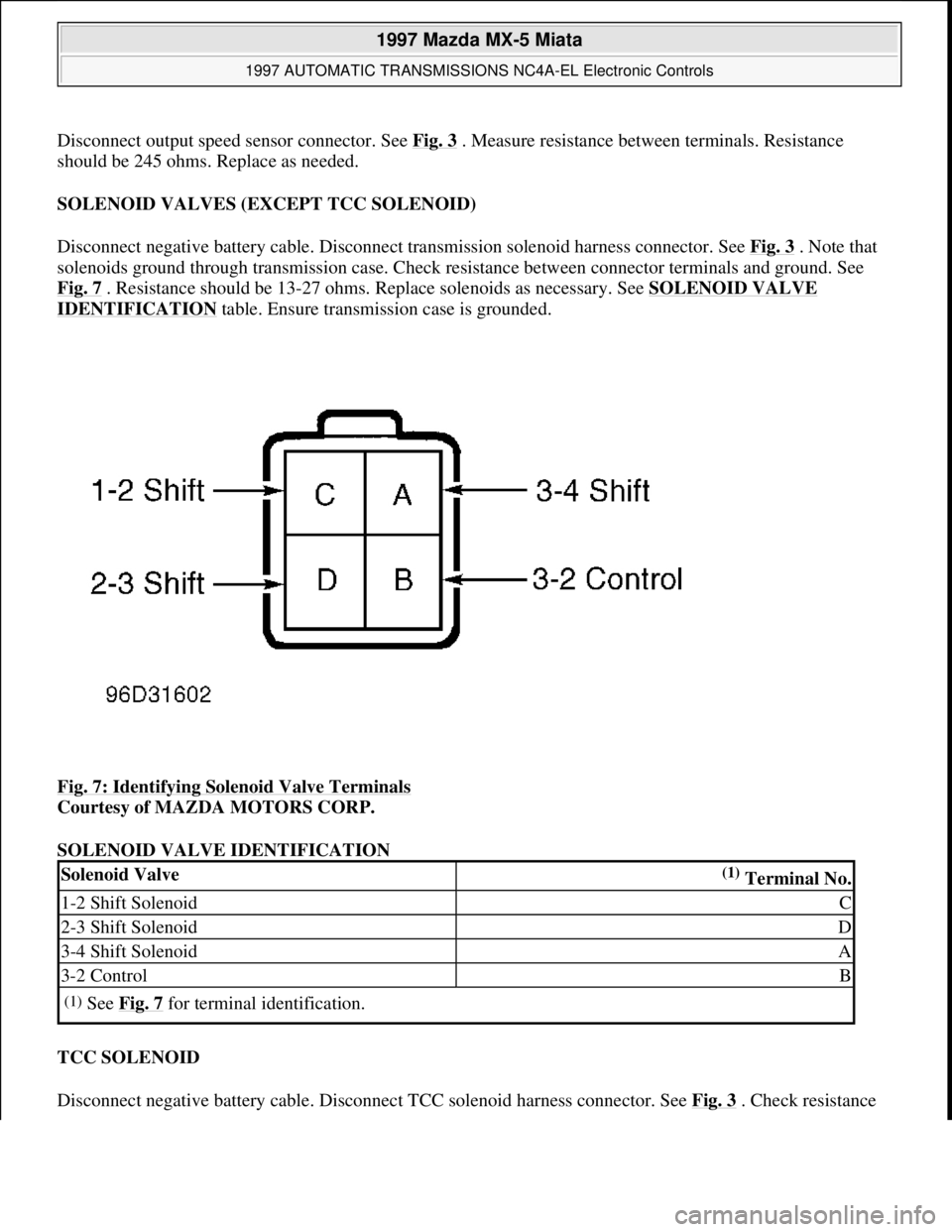
Disconnect output speed sensor connector. See Fig. 3. Measure resistance between terminals. Resistance
should be 245 ohms. Replace as needed.
SOLENOID VALVES (EXCEPT TCC SOLENOID)
Disconnect negative battery cable. Disconnect transmission solenoid harness connector. See Fig. 3
. Note that
solenoids ground through transmission case. Check resistance between connector terminals and ground. See
Fig. 7
. Resistance should be 13-27 ohms. Replace solenoids as necessary. See SOLENOID VALVE
IDENTIFICATION table. Ensure transmission case is grounded.
Fig. 7: Identifying Solenoid Valve Terminals
Courtesy of MAZDA MOTORS CORP.
SOLENOID VALVE IDENTIFICATION
TCC SOLENOID
Disconnect ne
gative battery cable. Disconnect TCC solenoid harness connector. See Fig. 3 . Check resistance
Solenoid Valve(1) Terminal No.
1-2 Shift SolenoidC
2-3 Shift SolenoidD
3-4 Shift SolenoidA
3-2 ControlB
(1)See Fig. 7 for terminal identification.
1997 Mazda MX-5 Miata
1997 AUTOMATIC TRANSMISSIONS NC4A-EL Electronic Controls
Microsoft
Sunday, July 05, 2009 1:35:04 PMPage 22 ÂĐ 2005 Mitchell Repair Information Company, LLC.